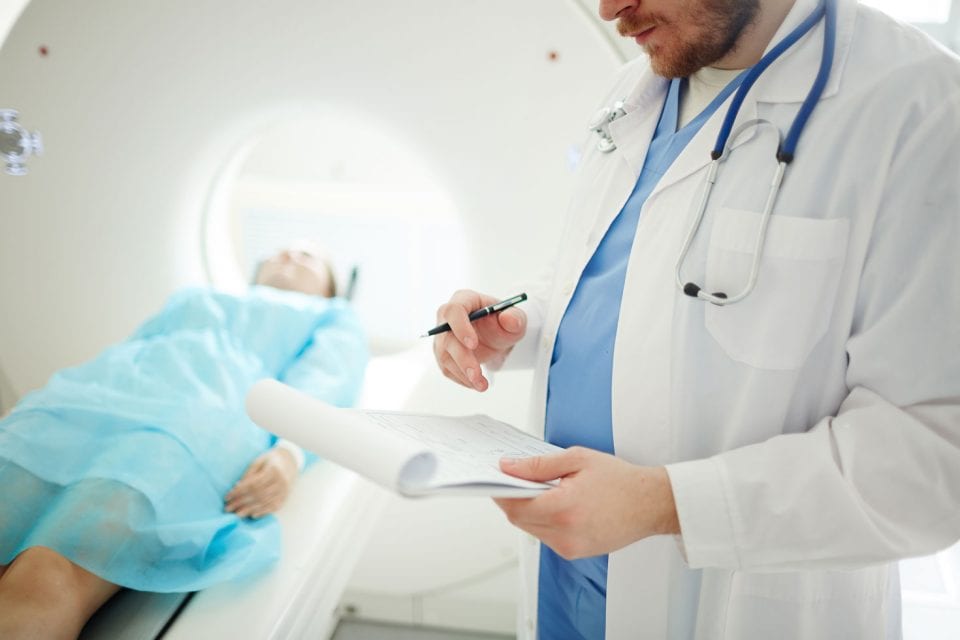
Interventional Spine Procedures
At Pinehurst Surgical Clinic, our spine surgeons proudly deliver expert diagnosis and treatment for lumbar spinal stenosis and other spine conditions to patients including:
- Cervical/thoracic/lumbar epidural injections
- Selective nerve root injections
- Facet joint injections
- Sacroiliac joint injections
- Peripheral nerve blocks
- Radiofrequency ablation
- Spinal cord stimulation
For additional information about our spinal procedures, please visit Dr. Daniel Williams website.
Lumbar Spinal Stenosis: Treatment for Spine Fractures
Lumbar spinal stenosis is a medical condition that results from the narrowing of the spinal canal, which compresses the nerves traveling through the lower back into the legs. Although lumbar spinal stenosis itself does not typically produce symptoms, the inflammation of the nerves due to increased pressure may bring about noticeable symptoms.
When present, these may include:
- Pain, weakness, or numbness in the legs, calves, or buttocks
- Pain radiating into one or both thighs and legs, similar to sciatica
- In rare cases, loss of motor functioning of the legs
- In rare cases, loss of normal bowel or bladder function
Surgical Treatment Options
For many patients, spinal surgery is the best way to relieve the pain caused by lumbar spinal stenosis.
You may be considered a candidate for spinal surgery if:
- Back and leg pain limits normal activity or impairs your quality of life
- You develop progressive neurological deficits, such as leg weakness and/or numbness
- You experience loss of normal bowel and bladder functions
- You have difficulty standing or walking
- Medication and physical therapy are ineffective
- You are in reasonably good health
The most common surgery in the lumbar spine is called decompressive laminectomy, in which the laminae (roof) of the vertebrae are removed by a neurosurgeon to create more space for the nerves.
Other types of surgery include anterior lumbar interbody fusion (ALIF), foraminotomy, laminotomy, laparoscopic spinal fusion, medial facetectomy, posterior lumbar interbody fusion (PLIF), posterolateral fusion and transforaminal lumbar interbody fusion (TLIF).
*Information from this article used with permission by The American Association of Neurological Surgeons.
Non-Surgical Treatment Options
Surgery is not always necessary in the treatment of lumbar spinal stenosis.
Pinehurst Surgical Clinic offers several non-surgical options, including:
- Anti-inflammatory medications and analgesics
- Physical therapy and/or prescribed exercises
- Epidural injections of cortisone
What is an Epidural Steroid Injection?
An epidural steroid injection is an injection of a long-lasting steroid into the epidural space, or the area that surrounds the spinal cord and the exiting nerves.
Epidural steroid injections reduce the inflammation and/or swelling of nerves in the epidural space, which may in turn help moderate pain, tingling and numbness and other related symptoms. These injections can also be used by our Pinehurst, NC pain management specialists as a beneficial diagnostic tool.
Preparing for Your Epidural at Pinehurst Surgical Clinic
Pinehurst Surgical Clinic recommends following the suggestions listed below to ensure your epidural goes smoothly and successfully:
- You may eat and drink the day of the injection.
- You must have someone to drive you home after the injection. You will not be allowed to drive for the remainder of the day following the injection.
- Diabetics should follow their regular medication schedule. Steroid injections may cause temporary elevation of your blood sugar.
- If you are taking an antibiotic or have a fever, please inform your nurse. You will be unable to receive the injection if you are taking antibiotics or have a fever.
- If you are taking blood thinners such as Plavix, Aspirin, Pletal or Coumadin, please notify our staff immediately. With the permission of the prescribing physician, these medications should be discontinued for up to seven days prior to the procedure.
During the procedure
During your epidural, you may feel pressure in your back for a few minutes as the steroid medication is being injected. Some patients will also experience tingling or pain in the affected leg. The entire procedure takes about 10 minutes, and you will be monitored for 15-30 minutes following the injection.
After the procedure
Although individual results may vary, most patients experience decreased pain following their epidural injection. Note that you may not see results until 7-10 days after the procedure.
You may take Advil, Tylenol or other pain medications prescribed by your physician, if you experience pain or discomfort in your back after the numbing medicine wears off. You may also apply ice to the injection site for up to 15 minutes to help decrease pain. Rest if you are fatigued and do not drastically increase your activity.
If you begin experiencing increased pain, numbness or weakness; difficulty with bladder or bowel control; redness, swelling or increasing pain at the injection site; or a headache persisting more than 24 hours following your injection, please contact Pinehurst Surgical Clinic immediately.
Schedule An Appointment
Make an appointment with one of our orthopaedic specialists today.
Neurological & Musculoskeletal Exams
When it comes to interventional pain management, a neurological and musculoskeletal test is often necessary to correctly diagnose and treat acute pain problems.
Spine Signs & Symptoms
If you are suffering from neck or low back pain, numbness, tingling or pain in your arms or legs you may have a problem originating from your spine.
In-Depth Testing & Diagnostics
A proper diagnosis of your spine, back or neck pain is a vital step in the pain management treatment process. At Pinehurst Surgical Clinic, the board-certified physicians at our Spine & Interventional Pain Management Center are trained in a variety of diagnostic tests and procedures related to your pain problem.
Pinehurst Surgical Clinic is a multi-specialty clinic comprised of ten specialty centers located in a state-of-the-art surgical facility in Pinehurst, NC. Our pain management specialists offer a variety of interventional spinal procedures at our Pinehurst and Sanford clinical offices, serving patients in Southern Pines, Fayetteville, Red Springs and all surrounding areas throughout North Carolina, South Carolina, and beyond.




